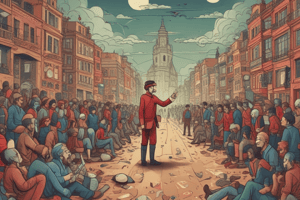Podcast
Questions and Answers
What is the primary conflict in a Marxist society, according to conflict theory?
What is the primary conflict in a Marxist society, according to conflict theory?
The primary conflict in a Marxist society is between social classes.
What does the term 'bourgeoisie' refer to in a Marxist context?
What does the term 'bourgeoisie' refer to in a Marxist context?
The owners of the means of production and the ruling class.
What is the concept of 'alienation' in Marxist theory?
What is the concept of 'alienation' in Marxist theory?
The process whereby the worker is made to feel foreign to the products of their own labor.
What is the term for the way the proletariat is led to believe their oppression is normal and that they can become the bourgeoisie if they work hard?
What is the term for the way the proletariat is led to believe their oppression is normal and that they can become the bourgeoisie if they work hard?
Signup and view all the answers
What term is used to describe the workers who are exploited by the bourgeoisie in a Marxist context?
What term is used to describe the workers who are exploited by the bourgeoisie in a Marxist context?
Signup and view all the answers
What is meant by 'value consensus' in the context of structural theory?
What is meant by 'value consensus' in the context of structural theory?
Signup and view all the answers
What is the term for a feeling of normlessness in society, where an individual doesn't know what it means to be normal?
What is the term for a feeling of normlessness in society, where an individual doesn't know what it means to be normal?
Signup and view all the answers
What are social facts, according to Durkheim?
What are social facts, according to Durkheim?
Signup and view all the answers
What is the main idea behind Durkheim's top-down theory of society?
What is the main idea behind Durkheim's top-down theory of society?
Signup and view all the answers
What are the two means of maintaining value consensus and social order, according to structural theory?
What are the two means of maintaining value consensus and social order, according to structural theory?
Signup and view all the answers
What is the key distinction between a manifest function and a latent function in social institutions?
What is the key distinction between a manifest function and a latent function in social institutions?
Signup and view all the answers
How do social institutions maintain value consensus, according to functionalism?
How do social institutions maintain value consensus, according to functionalism?
Signup and view all the answers
What is an example of a latent function, as demonstrated by the Hopi Indians' rain dance?
What is an example of a latent function, as demonstrated by the Hopi Indians' rain dance?
Signup and view all the answers
What are some of the external criticisms of functionalism?
What are some of the external criticisms of functionalism?
Signup and view all the answers
What is the consequence of a lack of socialisation and learning of norms and values, according to functionalism?
What is the consequence of a lack of socialisation and learning of norms and values, according to functionalism?
Signup and view all the answers
What is the main goal of specialist institutions in achieving social harmony, and how do they achieve it?
What is the main goal of specialist institutions in achieving social harmony, and how do they achieve it?
Signup and view all the answers
What is the key idea behind the Consensus Theory, and how does it relate to social institutions?
What is the key idea behind the Consensus Theory, and how does it relate to social institutions?
Signup and view all the answers
What is the Organic Analogy, and which sociologist is associated with it?
What is the Organic Analogy, and which sociologist is associated with it?
Signup and view all the answers
What are the four basic needs of society, according to Parsons, and how do they relate to social institutions?
What are the four basic needs of society, according to Parsons, and how do they relate to social institutions?
Signup and view all the answers
What are the three main criticisms of Parsons' assumptions, and how do they relate to his functionalist theory?
What are the three main criticisms of Parsons' assumptions, and how do they relate to his functionalist theory?
Signup and view all the answers
What is the primary focus of structural conflict approaches in sociology?
What is the primary focus of structural conflict approaches in sociology?
Signup and view all the answers
What is the main idea behind interactionist approaches in sociology?
What is the main idea behind interactionist approaches in sociology?
Signup and view all the answers
What are the two stages of socialization, and where do they occur?
What are the two stages of socialization, and where do they occur?
Signup and view all the answers
Who is considered the father of modern sociology, and what contribution did he make to the field?
Who is considered the father of modern sociology, and what contribution did he make to the field?
Signup and view all the answers
What is the key difference between macro and micro approaches in sociology?
What is the key difference between macro and micro approaches in sociology?
Signup and view all the answers




